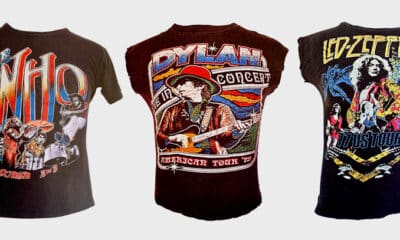Case Studies
A Printer’s Best Tool: Reviewing the Latest Heat Presses
Selecting the right machine to produce sublimation, heat transfers, DTG, DTF, HTV and more.
Published
3 months agoon
HEAT-TRANSFER MACHINES for decorating garments got an early start in the 1960’s providing the hippy movement with a way to embellish T-shirts with “peace and love” designs. Many people thought that T-shirt printing would be a passing fad, but in fact it has become a multimillion-dollar enterprise. Today, heat-transfer printing is a mainstream decoration method used worldwide.
It’s important to look back and understand that, in the early years, a T-shirt only was available in white and was considered to be an undergarment and not worn as outerwear. This was until the introduction of heat-applied graphics and direct screen-printed designs on tees. T-shirt shops started popping up in cities across the U.S. from souvenir stores at the beach to local sporting goods shops applying heat-applied names and numbers on team jerseys.
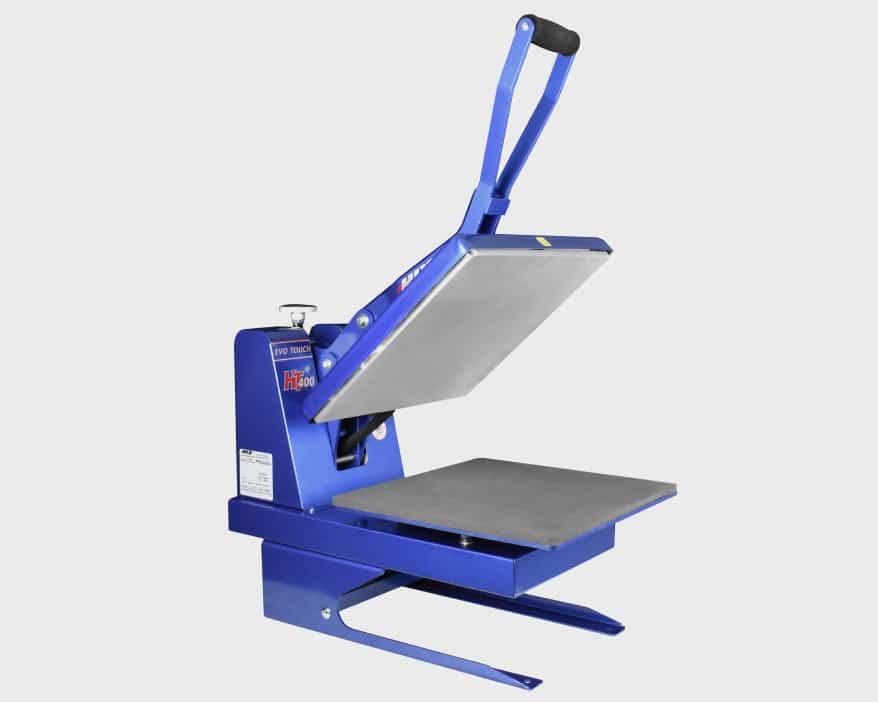
This is a 15” x 15” manual press with a LCD touch-screen controller. The one pictured has a “splitter stand” attachment to allow the garment being pressed to be split or dressed over the platen.
The use of the heat press has come full circle in our industry starting with the boom of heat-transfer designs of the 60’s to the latest surge in popularity created by the introduction of DTF (direct-to-film) heat transfers. Screen-printed plastisol transfers still are mainstream in the garment decoration sector but the introduction of DTF transfers has opened a whole new opportunity for garment decorators to make their own custom DTF heat transfers. This can be done in house using newly introduced equipment instead of purchasing custom-made heat transfers from outside sources. Although there are several great sources for ordering preprinted transfers. DTF transfers have truly become a game changer for garment decorators in the apparel end of the screen-printing industry.
Getting Started
First, define the segment of the market that your business will specialize in such as local team sports, souvenir, advertising specialty, work apparel, and EMS/ fire department uniforms, just to name a few. With your niche defined, the next step is to choose the right model of heat press for your application. Remember, heat-transfer equipment also can be used to decorate other products such coasters, drink coolers, hats, mugs and more so decide what products you can offer your customers in addition to apparel.
The next step is to do your research on what size heat press will be needed to meet your image and production requirements. The two main heat platen sizes are 15” x 15” and 16” x 20”. For jumbo garment designs and oversized prints, there are 20” x 24” up to 44” x 64” size machines available. Most of the forementioned jumbo heat presses are used in sublimation printing on large metal signs and for sublimating ceramic tile murals.
AdvertisementSwing-Away vs. Clamshell Design
Heat-transfer machines come in two main configurations, the swing-away and the clamshell design. With the swing-away version, the heat platen swings away from the lower platen while the clamshell machine opens straight up above the garment being decorated. Athletic uniform decorators prefer the swing-away machine design since the heat platen swings away allowing easy access to the garment for laying out and lining up team names and numbering before heat pressing.
Swing-away machines also are popular with sublimation printers since the swing-away feature allows the machine operator full access to the lower platen to lay out a tile mural, or multiple substrates to be heat transferred. The swing-away design also is ideal for sublimation printing on thick substrates since the gap distance between the substrate and heat casting is adjustable on swing-away presses for heat pressing items up to 1 ¾” thick.
As the name implies, the clamshell design opens up vertically like a clamshell without the need to swing away the heat platen. Eliminating this “swing-away step” is a big-time saver on long production runs saving anywhere from five to 10 seconds per transfer cycle. This saved time really can add up by the end of an eight-hour production shift.
Another advantage with the clamshell design is that the machine requires a smaller footprint, taking up less production space (since the machine opens straight up) and does not take up extra counter space like swing-away presses require. Manual clamshell machines also are more portable than the heavier swing-away presses making the clamshell press the preferred press to use at on-site event printing.
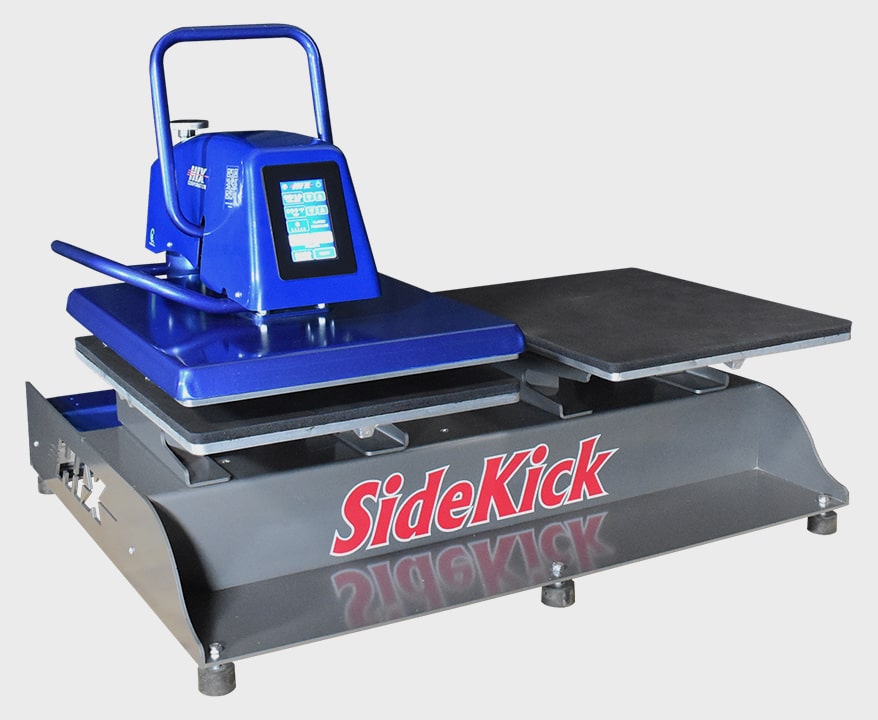
Shown is a high-output manual shuttle press that provides the operator two lower platens to work with. While one garment is being heat pressed the operator can load the second garment to be ready to go.
High Output Transfer Application
With the introduction of DTF transfers, there is an increased interest in finding the fastest heat-transfer machine to apply DTF transfers on long production runs. Although DTF transfers are new, the need for high throughput transfer application is not a new phenomenon and there are many high throughput, automatic heat-press machines on the market from multi-heat head carousel presses to inline shuttle systems.
Carousel heat press designs and inline shuttle presses have been around for decades and are being re-visited again in the DTF market. Before investing in a high throughput heat-transfer system, be sure to do your homework and buy from a reputable manufacturer. Also, ask to talk with an end user that is using the machine in production before buying.
Advertisement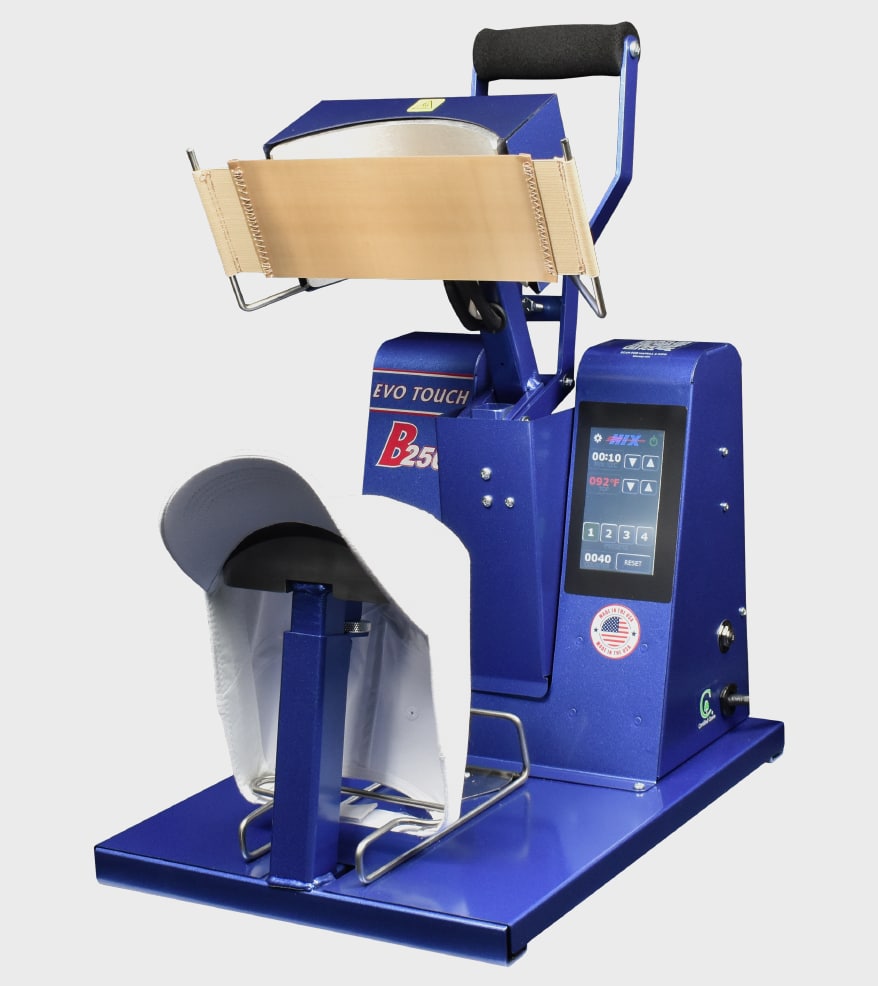
A cap press is equipped with a Teflon ™ blanket that is designed to hold the transfer in alignment and to allow some initial pressure against the transfer when the machine is opened. This feature reduces the chance of the edges of the transfer from lifting off the hat surface.
Most high-volume transfer shops use multiple single-head, air-automatic presses and one person operates two machines by alternating back-and-forth between the two presses. Here’s an example: While one machine is locked down and transferring, the operator peels the transfer backer from the garment just transferred on the second press. The operator then works back-and-forth between the two machines. Some high-production shops will have between 30 and 50 air automatic heat presses lined up in full operation.
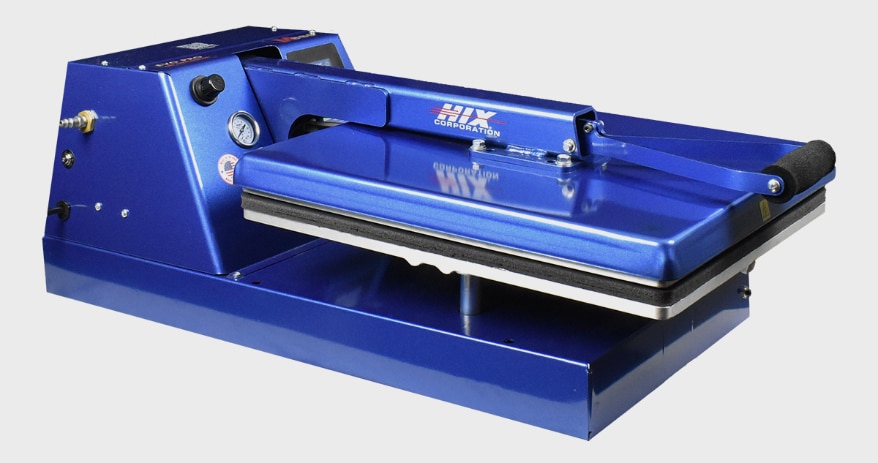
This air-operated, commercial-grade clamshell press is used in high-production applications and the automatic feature substantially reduces operator fatigue on long production runs.
Features & Application Tips
An important feature to have on a heat-transfer machine is a pre-press setting or a manual pre-press button used for a quick two-to-three second pressing of the garment before applying the transfer. This pre-press step is used to remove moisture from the garment and smooth the garment surface prior to applying the transfer.
When applying heat transfers (plastisol or DTF) and after the heat pressing cycle is done, avoid opening the heat platen too rapidly since this can cause the edges of the transferred image to lift from the garment since the ink is still in a melted state. To avoid this problem with a manual heat press, it is best to crack the machine open slightly at the beginning and then fully open the press. Air-automatic machines provide this easy-open feature as the machine opens.
This slight delay in releasing the upper heat casting from the transfer/garment can reduce misprints caused from the outer edges on the design lifting off the garment surface.
For shops using multiple pneumatic automatic heat presses, it is important to select the right size air compressor for your shop to run that many presses. Always consult the machine manufacturer for the required CFM rating for its machine. And one last tip: Always get a large air reservoir tank when running multiple machines off of one air compressor — the bigger the air tank the better.
Now a few transferring tips. For applying heat transfers to tri-blends and 100% polyester garments, it is best to split or “dress” the garment over the lower platen so that only one layer of the garment is being heat pressed at a time. Using a Teflon ™ pad cover on the lower platen allows for the garment to be split easily when loading the garment over the rubber surface of the platen. It is important to get a heat press that allows the feature of splitting the garment.
It also is important to have a good rubber pad on your machine and, if it’s been several years since the lower pad was changed, then it is probably time for a new pad. Typically after several years of heavy use, the lower pad will develop “low” spots in some areas caused by the pad being compressed repeatedly over time. This causes the rubber pad to lose some rebound memory.
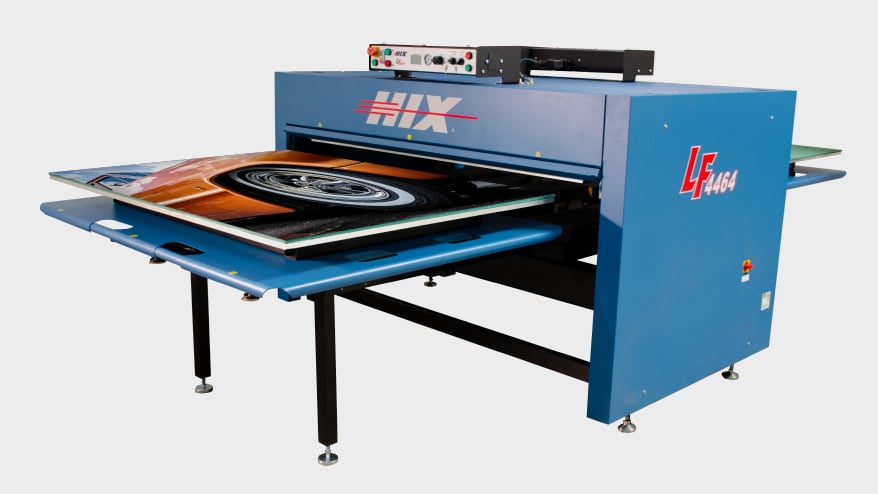
This jumbo heat press is designed for allover sublimation printing on garments and for heat pressing ceramic tile murals, metal signage, and more. The heat platen size is 44” x 64”.
Machine Accessories
Heat-press accessories available from manufacturers include heat-press stands, pad protectors, heat-platen covers, PTFE cover sheets, interchangeable lower platens, laser alignment attachments and more. Check with your equipment manufacturer for more information on what accessories you will need for the job at hand.
Whether you are purchasing a heat press for a small shop, working from home, or purchasing multiple heat presses for a large garment manufacturing company, just remember the heat press is the heart of your business. So do your research in advance and select the best quality heat press for your operation.
AdvertisementJames Ortolani has been in the decorated apparel industry for 40 years, specializing in screen-printing and heat-transfer applications. He was inducted into the Academy of Screen and Digital Print Technologies (ASDPT) in 2011 for his contributions to the advancement of the screen-printing industry. James is currently the Graphic Sales and Product Development Manager for HIX Corp. based in Pittsburg, Kan. Contact him at jortolani@hixcorp.com.

SPONSORED VIDEO
Let’s Talk About It
Creating a More Diverse and Inclusive Screen Printing Industry
LET’S TALK About It: Part 3 discusses how four screen printers have employed people with disabilities, why you should consider doing the same, the resources that are available, and more. Watch the live webinar, held August 16, moderated by Adrienne Palmer, editor-in-chief, Screen Printing magazine, with panelists Ali Banholzer, Amber Massey, Ryan Moor, and Jed Seifert. The multi-part series is hosted exclusively by ROQ.US and U.N.I.T.E Together. Let’s Talk About It: Part 1 focused on Black, female screen printers and can be watched here; Part 2 focused on the LGBTQ+ community and can be watched here.
You may like
Advertisement

Atlantis Headwear Goes Solar for Sustainable Future

Comfort Colors Announces New Proprietary Dyeing Process Called “Pigment Pure”

10 Production Scheduling Secrets That Will Have Your Team Ready to Rock
Advertisement
Subscribe

Bulletins
Get the most important news and business ideas from Screen Printing magazine's news bulletin.
Advertisement
Most Popular
-

 Case Studies2 months ago
Case Studies2 months agoHigh-Density Inks Help Specialty Printing Take Center Stage
-

 Art, Ad, or Alchemy2 months ago
Art, Ad, or Alchemy2 months agoF&I Printing Is Everywhere!
-

 Andy MacDougall2 months ago
Andy MacDougall2 months agoFunctional and Industrial Printing is EVERYWHERE!
-

 Columns4 weeks ago
Columns4 weeks ago8 Marketing Mistakes Not to Make When Promoting Your Screen Printing Services Online
-

 Editor's Note3 weeks ago
Editor's Note3 weeks agoLivin’ the High Life
-

 Marshall Atkinson3 weeks ago
Marshall Atkinson3 weeks agoHow to Create a Winning Culture in Your Screen-Printing Business
-

 Thomas Trimingham2 months ago
Thomas Trimingham2 months ago“Magic” Marketing for Screen Printing Shops
-

 News & Trends2 months ago
News & Trends2 months agoWhat Are ZALPHAS and How Can You Serve Them in Your Print Business?


